Creating a Healthy Environment for Elderly People in Urban Public Activity Space
Abstract
1. Introduction
1.1. Urbanization Development
1.2. Ageing Society
1.3. Noise Problem in China
2. Methodology
2.1. Case Study Location
2.2. Research Design
Influencing Factors
2.3. Questionnaire
2.4. Sound Collection
2.5. Sound Model
2.5.1. Sound Sensitivity Model Construction
2.5.2. Sound Intensity Model Construction
2.5.3. People Number Model
3. Results
3.1. Questionnaire
3.2. Model Results Analyses
3.2.1. Sound Intensity Model Results
3.2.2. Number of People Model Results
3.3. Comprehensive Analysis of Urban Park Space
4. Discussion
4.1. Planning Principle for Elderly Urban Park Activity Space
4.1.1. Plant Density
4.1.2. Degree of Structural Enclosure
4.1.3. Functional Mixing Degree
4.2. Planning Principle Optimization
5. Conclusions
Author Contributions
Funding
Conflicts of Interest
References
- Bertino, G.; Fischer, T.; Puhr, G.; Langergraber, G.; Österreicher, D. Framework conditions and strategies for pop-up environments in urban planning. Sustainability (Basel) 2019, 11, 7204. [Google Scholar] [CrossRef]
- Pompili, T. Networks within cities and among cities: A Paradigm for Urban Development and Governance. In Proceedings of the 56th European Regional Science Association Congress, Vienna, Austria, 23–26 September 2006. [Google Scholar]
- Borowczyk, J. Sustainable urban development: Spatial analyses as novel tools for planning a universally designed city. Sustainability (Basel) 2018, 10, 1407. [Google Scholar] [CrossRef]
- Lukermann, B.L.; Nordstrom, R. Eco-city dimensions: Healthy communities, healthy planet-Roseland, M. J. Am. Plann. Assoc. 1997, 63, 513–515. [Google Scholar]
- Bibri, S.; Krogstie, J. Smart eco-city strategies and solutions for sustainability: The cases of Royal Seaport, Stockholm, and Western Harbor, Malmö, Sweden. Urban Sci. 2020, 4, 11. [Google Scholar] [CrossRef]
- Wu, J.; Yang, S.; Zhang, X. Interaction analysis of urban blue-green space and built-up area based on coupling model—A case study of Wuhan Central City. Water 2020, 12, 2185. [Google Scholar] [CrossRef]
- Tang, B.S.; Wong, S.W. A longitudinal study of open space zoning and development in Hong Kong. Landsc. Urban Plann. 2008, 87, 258–268. [Google Scholar] [CrossRef]
- Meng, L.; Wen, K.; Zeng, Z.; Brewin, R.; Fan, X.; Wu, Q. The Impact of street space perception factors on elderly health in high-density cities in Macau-analysis based on street view images and deep learning technology. Sustainability (Basel) 2020, 12, 1799. [Google Scholar] [CrossRef]
- Olwig, K. Life between buildings: Using public space. Landsc. J. 1989, 8, 54–55. [Google Scholar] [CrossRef]
- Official site of “Ao-re Nagaoka” [EB/OL]. Available online: http://www.ao-re.jp (accessed on 21 September 2018).
- Shi, L.; Halik, Ü.; Abdulla, A.; Welp, M.; Mamat, Z. Urban green space accessibility and distribution equity in an arid oasis city: Urumqi, China. Forests 2020, 11, 1–17. [Google Scholar] [CrossRef]
- Li, Z.; Yang, Y.; Hou, B.; Guo, Y. Analysis of environmental noise control in urban park based on soundscape. J. Inner Mong. Agric. Univ. (Natural Science Edition). 2020, 1–9. [Google Scholar] [CrossRef]
- United Nations. World Population Ageing. 2017. Available online: https://www.Un.Org/en/ (accessed on 15 August 2017).
- Zeping, R.; Chai, X.; Zhe, Z. Characteristics and Trends of Aging Population in China; China Annual Report; National Bureau of Statistics of China: Beijing, China, 2020; Volume 6, pp. 13–14.
- Ying, W. Study on the Optimization of Elderly People’s Activity Space in Shenyang Comprehensive Park based on POE. Ph.D. Thesis, Shenyang Jianzhu University, Shenyang, China, 2017. [Google Scholar]
- Sariyamon, T.; Doungjai, B.; Murallitharan, M.; Thang, H.; Nguyen, M.Y.; Myo, N.A.; Aung, H.M. Age-friendly environments in ASEAN plus three: Case studies from Japan, Malaysia, Myanmar, Vietnam, and Thailand. Int. J. Environ. Res. Public Health 2020, 17, 4523. [Google Scholar]
- Sumari, N.S.; Xu, G.; Ujoh, F.; Korah, P.I.; Ebohon, O.J.; Lyimo, N.N. A geospatial approach to sustainable urban planning: Lessons for Morogoro Municipal Council, Tanzania. Sustainability (Basel) 2019, 11, 6508. [Google Scholar] [CrossRef]
- Long, J.; Li, Z.; Gao, Y. Effect of urbanization gradient on the acoustic environments of parks in Guangzhou. Guangdong Gard. 2019, 41, 42–47. [Google Scholar]
- Xu, J. Guangzhou Drafts Legislation Limiting Noise in Public Parks. China Daily. 10 December 2013. Available online: https://www.chinadaily.com.cn/kindle/2013-11/15/content_17107174.htm (accessed on 10 December 2013).
- Wiernik, B.M.; Ones, D.S.; Dilchert, S. Age and environmental sustainability: A meta-analysis. J. Manag. Psychol. 2013, 28, 826–856. [Google Scholar] [CrossRef]
- Chawla, L. Identity and the natural environment: The psychological significance of nature. J. Environ. Psychol. 2004, 24, 406–408. [Google Scholar] [CrossRef]
- Zhao, F.; Liu, Z.; Suli, T.U. Research on activity space design for the elderly in city parks based on POE—A case study of Suzhou Park. J. Suzhou Univ. Ence Technol. 2015, 2, 7. [Google Scholar]
- Vaz, C.T.; de Souza Andrade, A.C.; Proietti, F.A.; Xavier, C.C.; de Lima Friche, A.A.; Caiaffa, W.T. A multilevel model of life satisfaction among old people: Individual characteristics and neighborhood physical disorder. BMC Public Health 2019, 19, 861. [Google Scholar]
- Jing, M. In Two Years, Shenyang Will Enter the Population Ageing. 2018. Available online: http://liaoning.nen.com.cn/system/2018/05/03/020489980.shtml (accessed on 15 September 2020).
- Chen, F.; Song, L.; Li, M. Study on the post occupancy evaluation of Youth Park in Shenyang. J. Shenyang Agric. Univ. (Soc. Sci. Ed.) 2009, 11, 174–177. [Google Scholar]
- Fu, Y. A study on evaluation and influencing factors of residents’ satisfaction of Shenyang urban park. J. Shenyang Agric. Univ. 2018, 11, 9. [Google Scholar]
- Hu, S.; Fan, Y.; Zhang, T. Assessing the effect of land use change on surface runoff in a rapidly urbanized city: A case study of the central area of Beijing. Land 2020, 9, 17. [Google Scholar] [CrossRef]
- Sugiarto, H.; Chung, N.; Lai, C.; Chew, L. Socioecological regime shifts in the setting of complex social interactions. Phys. Rev. E 2015, 91, 062804. [Google Scholar] [CrossRef] [PubMed]
- Newman, G.; Shi, T.; Yao, Z.; Li, D.; Sansom, G.; Kirsch, K.; Casillas, G.; Horney, J. Citizen science-informed community master planning: Land use and built environment changes to increase flood resilience and decrease contaminant exposure. Int. J. Environ. Res. Public Health 2020, 17, 486. [Google Scholar] [CrossRef] [PubMed]
- Liu, H. Research on the Rationality of Urban Green Space Layout. Ph.D. Thesis, Tongji University, Shanghai, China, 2008. [Google Scholar]
- Ulrich, R.S. Visual landscapes and psychological well-being. Landsc. Res. 1979, 4, 17–23. [Google Scholar] [CrossRef]
- Ulrich, R.S.; Addoms, D.L. Psychological and recreational benefits of a residential park. J. Leis. Res. 1981, 1, 43–65. [Google Scholar] [CrossRef]
- Kaplan, R.; Kaplan, S. The Experience of Nature: A Psychological Perspective; Cambridge University Press: Cambridge, MA, USA, 1989. [Google Scholar]
- Helson, H. Adaptation-level as a basis for a quantitative theory of frames of reference. Psychol. Rev. 1948, 55, 297–311. [Google Scholar] [CrossRef]
- Bellini, S. Social skill deficits and anxiety in high-functioning adolescents with autism spectrum disorder. Focus Autism Other Dev. Disabil. 2004, 19, 78–86. [Google Scholar] [CrossRef]
- Zhou, C.; Wu, Y. A Planning Support Tool for Layout Integral Optimization of Urban Blue-Green Infrastructure. Sustainability 2020, 12, 1613. [Google Scholar] [CrossRef]
- Dong, Z. Acoustic Landscape Survey in Shenyang Zhao Mausoleum Park. Ph.D. Thesis, Shenyang Agricultural University, Shenyang, China, 2020. [Google Scholar]
- Zhong, G. Working Principle of sound level meter. Electroacoust. Technol. 2002, 5, 65–66. [Google Scholar]
- Zheng, H.; Bai, J. Discussion on the use and Maintenance of sound level Meter. Light Ind. Stand. Qual. 2018, 4, 76–77. [Google Scholar]
- Yu, Y.; Zhang, W.; Fu, P.; Huang, W.; Li, K.; Cao, K. The Spatial Optimization and Evaluation of the Economic, Ecological, and Social Value of Urban Green Space in Shenzhen. Sustainability 2020, 12, 1844. [Google Scholar] [CrossRef]
- Dlamini, S.; Tesfamichael, S.G.; Shiferaw, Y.; Mokhele, T. Determinants of Environmental Perceptions and Attitudes in a Socio-Demographically Diverse Urban Setup: The Case of Gauteng Province, South Africa. Sustainability 2020, 12, 3613. [Google Scholar] [CrossRef]
- Enami, M.; Takei, Y.; Inaba, H.; Yachida, T.; Ohta, K.; Maeda, T.; Goto, Y. Differential effects of ageing and BLS training experience on attitude towards basic life support. Resuscitation 2011, 82, 577–583. [Google Scholar] [CrossRef] [PubMed]
- Chen, L.; Zhang, L. Summery and problems of studies on noise reduction by green land. J. Anhui Agric. Sci. 2012, 40, 2233–2235. [Google Scholar]
- Chen, Q.; Duan, H. Evaluation and analysis of noise reduction characteristics of urban road green belt. J. Qingdao Univ. Technol. 2015, 36, 49–53. [Google Scholar]
- Quan, J.; Zhao, C. Discussion on environmental Noise and human Health. Taiyuan Sci. Technol. 1998, 6, 3–5. [Google Scholar]
- Li, W.; Wei, Y. Urban noise pollution and prevention in China. North. Environ. 2012, 24, 175–176. [Google Scholar]
- Gao, P.; Wang, F.; Hou, X. Research on the Structure and Spatial Layout of Green Space in Hengshui city. Mod. Rural Sci. Technol. 2013, 4, 56–57. [Google Scholar]
- Hui, X.; Chen, J.; Liu, Y.; Ma, W.; Luo, J. Status and function of leisure Forest Park construction for citizens in Ningxia. Ningxia For. 2020, 3, 32–33. [Google Scholar]
- Liang, X. Functional Analysis and Spatial Distribution Characteristics of suburban forest Parks. Ph.D. Thesis, Guangzhou University, Guangzhou, China, 2012. [Google Scholar]

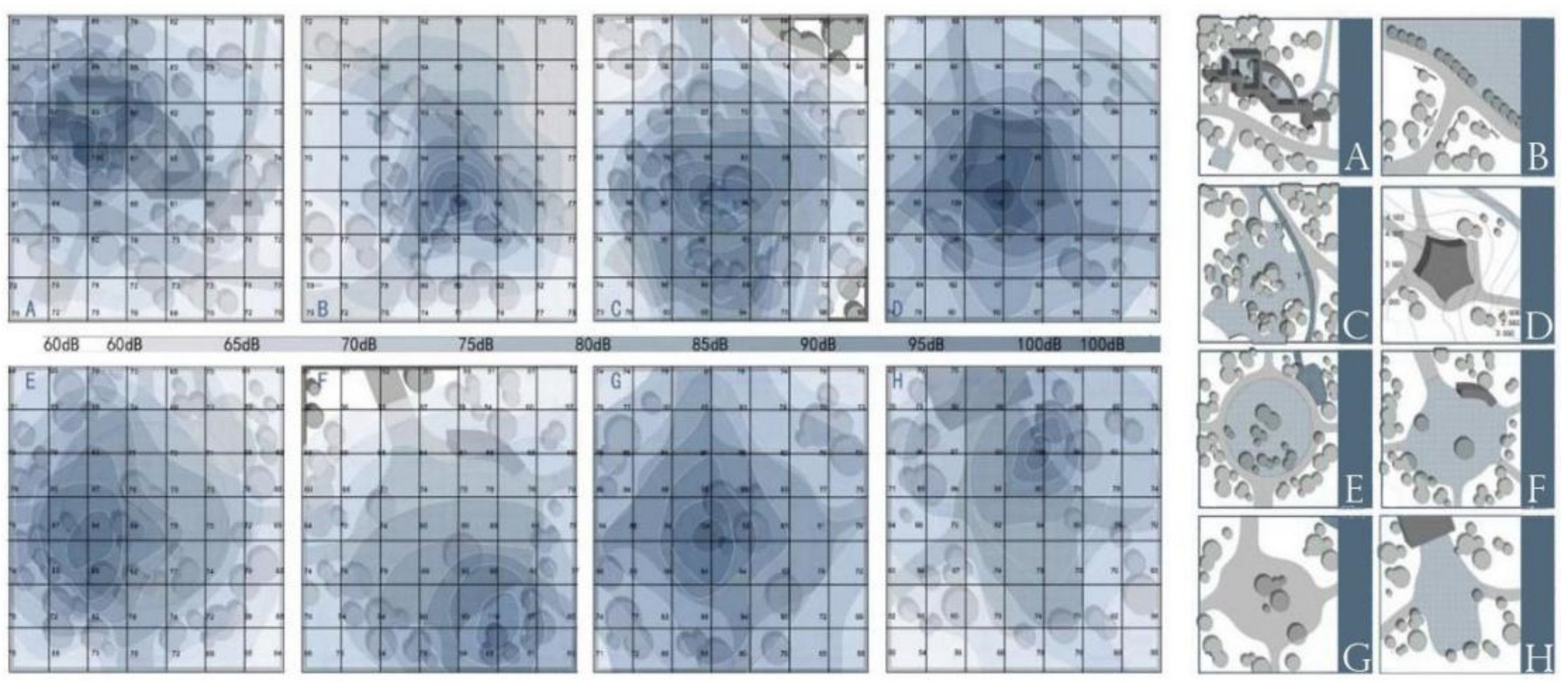
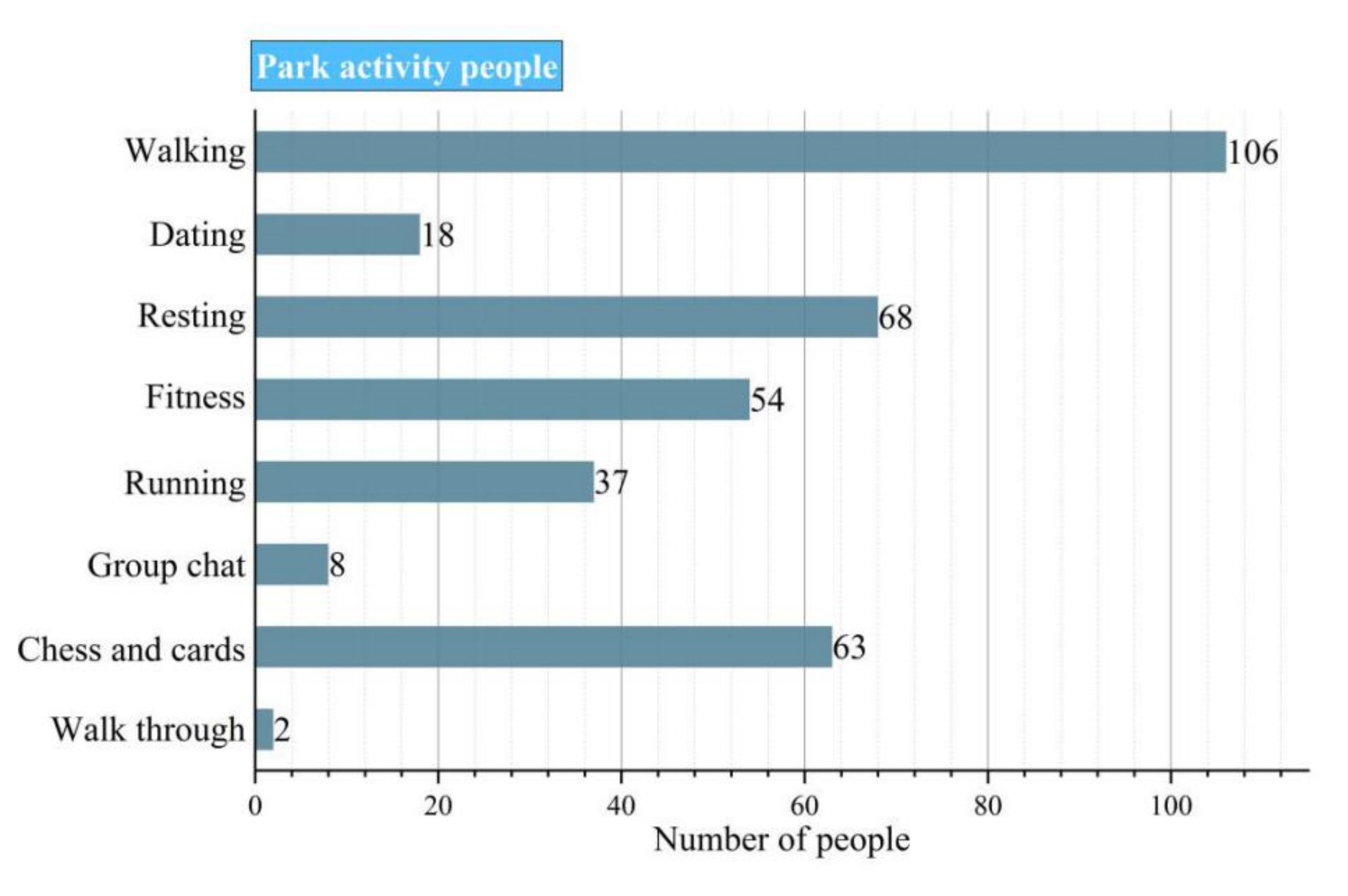
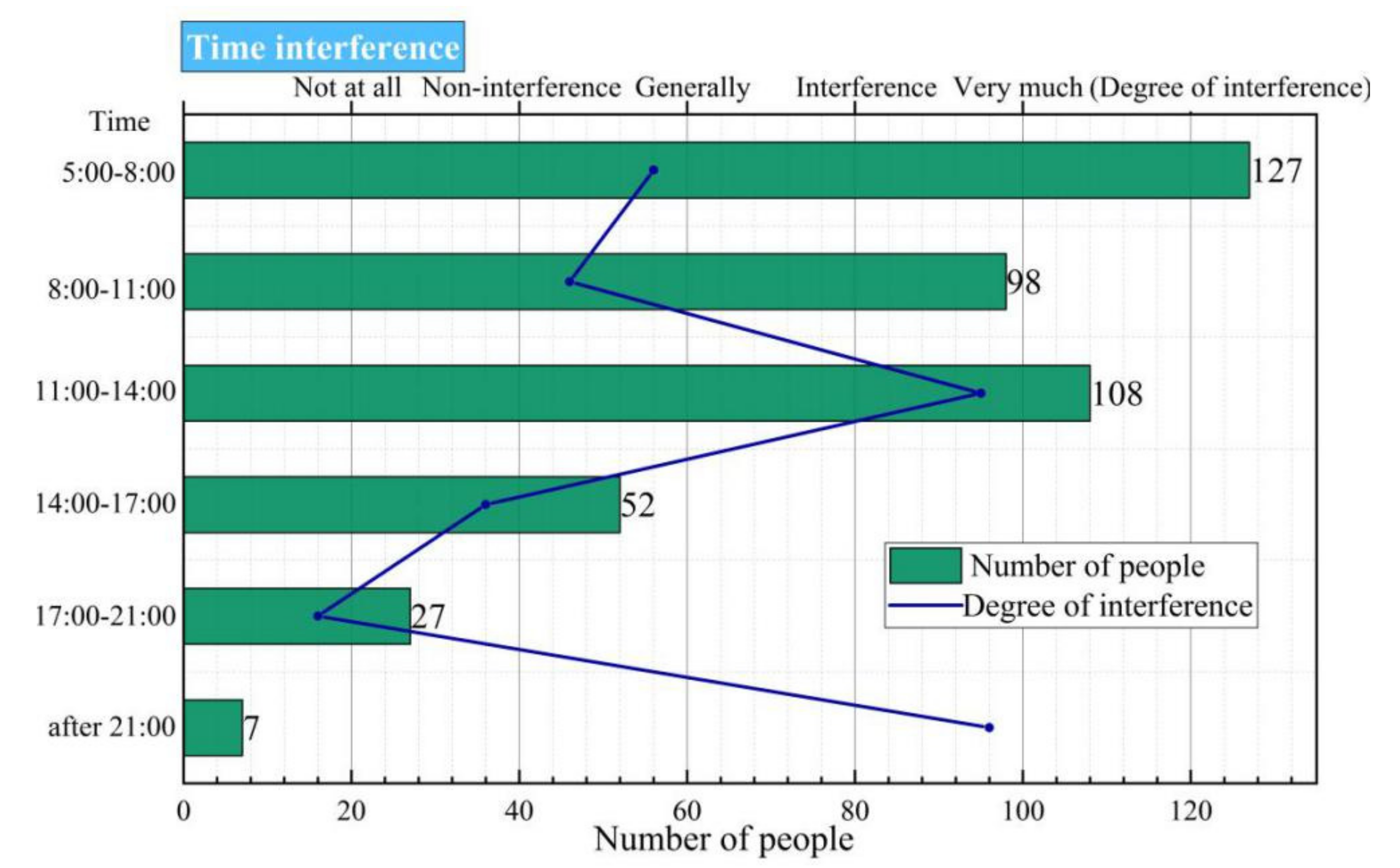
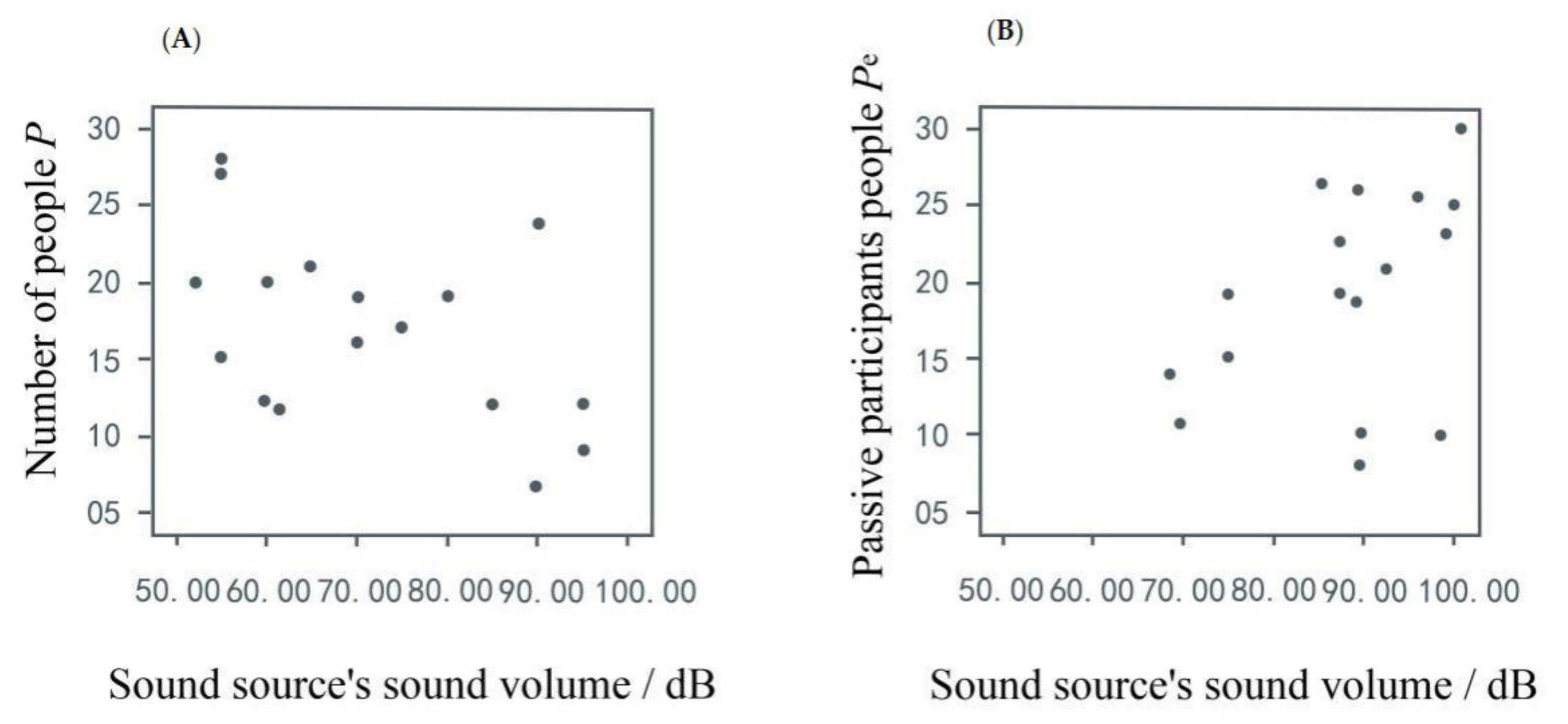

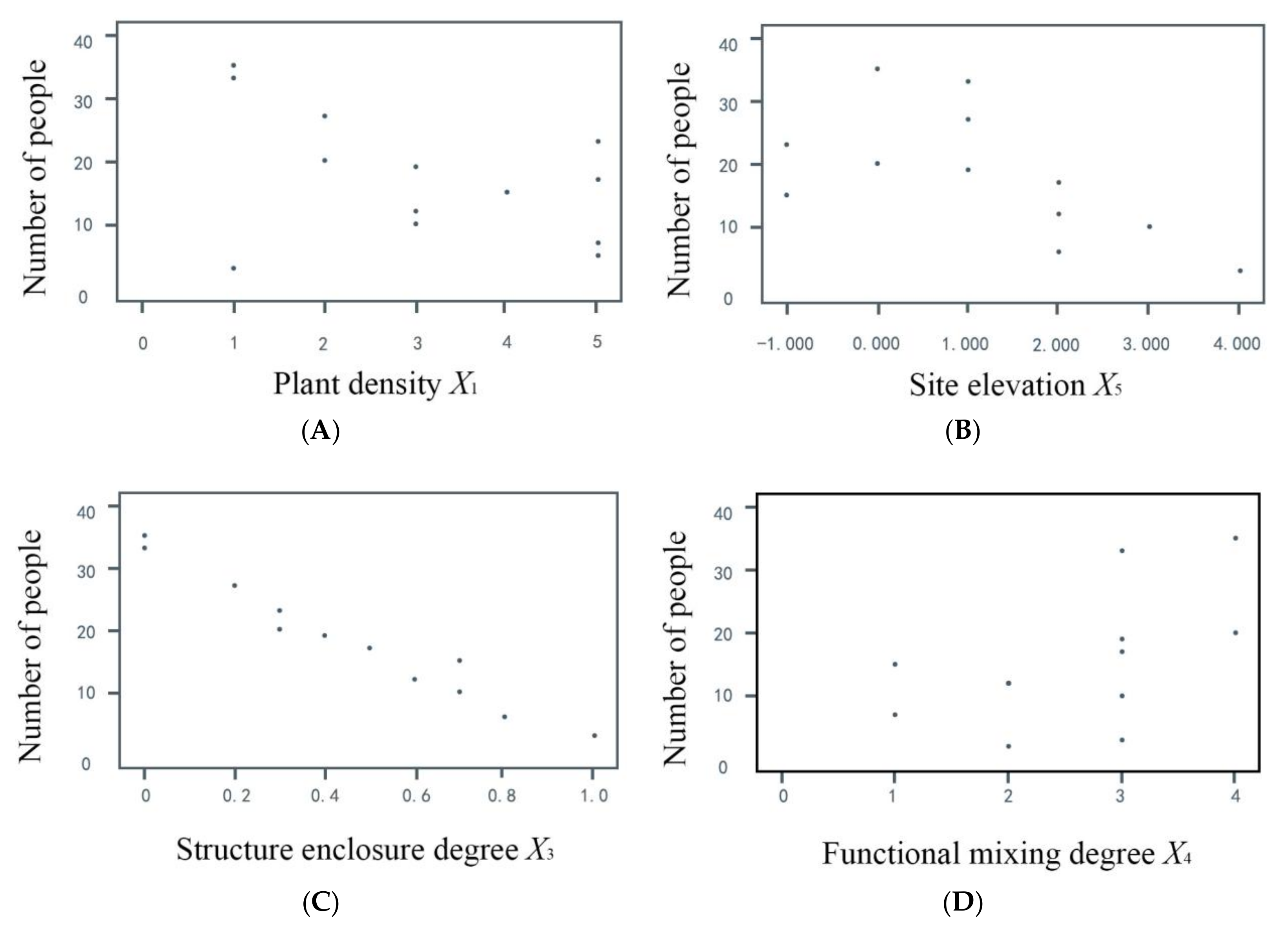

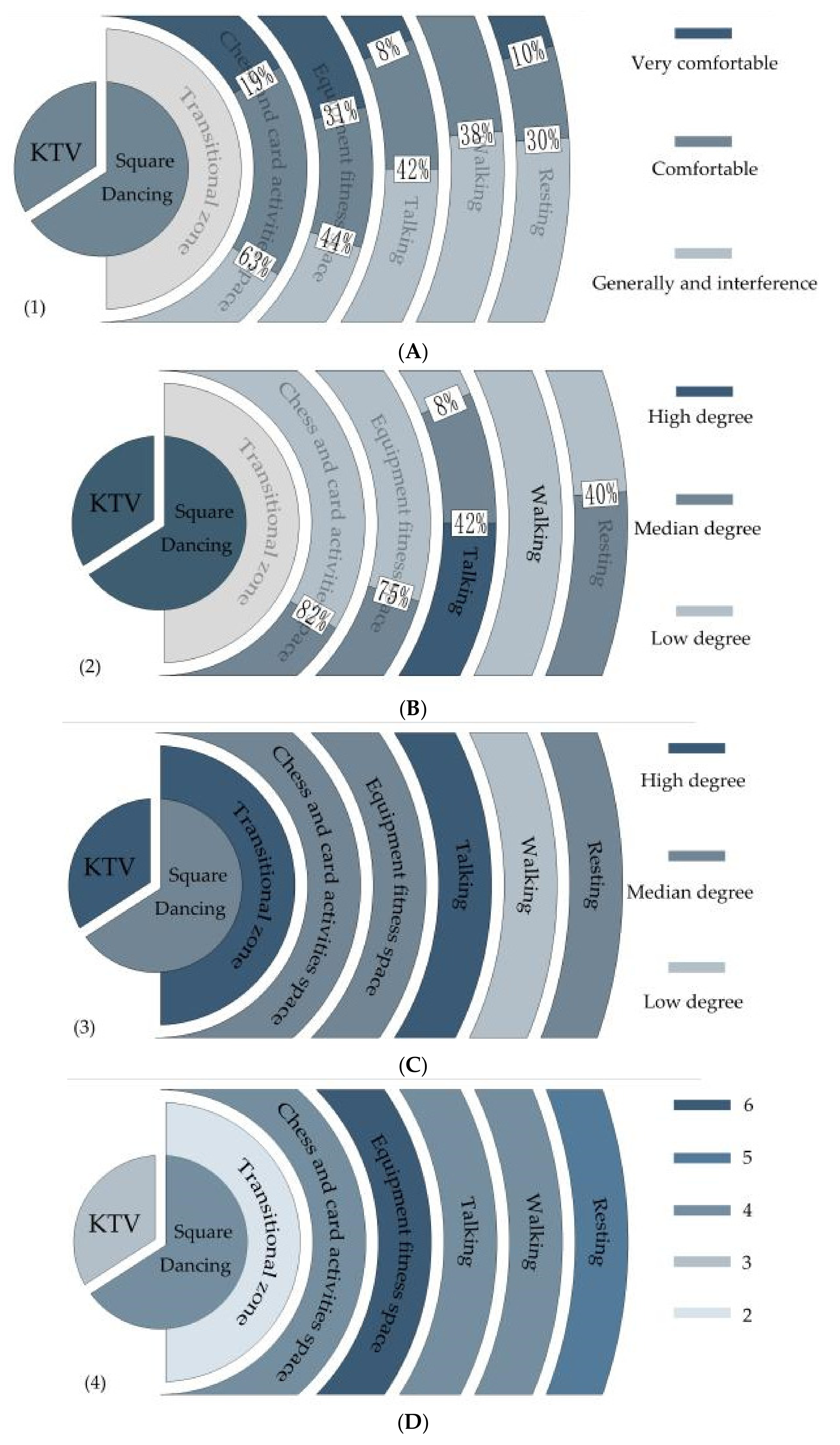
| Author | Theory | Factor |
|---|---|---|
| Ulrich | Stress Reduction Theory | Plant Density |
| Kaplan | Preference Matrix Theory | Structure Enclosure, Site Elevation |
| Helson | Adaptation Level Proposed | Functional Mixing Degree |
| Bellini | Arousal Theory | Virescence Graceful Degree |
| Coefficient a | |||||||
|---|---|---|---|---|---|---|---|
| Model | Unstandardized Coefficient | Standardized Coefficient | t | Significance | Collinear Statistics | Collinear Statistics VIF | |
| B | Standard Error | Beta | Tolerance | ||||
| C | 6.875 | 8.800 | 0.781 | 0.464 | |||
| X1 | 28.192 | 10.662 | 0.628 | 2.644 | 0.038 | 0.031 | 9.084 |
| X2 | 10.757 | 6.243 | 0.193 | 1.723 | 0.136 | 0.139 | 7.716 |
| X3 | −44.895 | 6.323 | −1.209 | −7.100 | 0.000 | 0.061 | 8.514 |
| X4 | 16.101 | 5.429 | 0.320 | 2.966 | 0.025 | 0.151 | 6.644 |
| X5 | 0.850 | 0.673 | 0.097 | 1.262 | 0.254 | 0.300 | 3.335 |
© 2020 by the authors. Licensee MDPI, Basel, Switzerland. This article is an open access article distributed under the terms and conditions of the Creative Commons Attribution (CC BY) license (http://creativecommons.org/licenses/by/4.0/).
Share and Cite
Shan, W.; Xiu, C.; Ji, R. Creating a Healthy Environment for Elderly People in Urban Public Activity Space. Int. J. Environ. Res. Public Health 2020, 17, 7301. https://doi.org/10.3390/ijerph17197301
Shan W, Xiu C, Ji R. Creating a Healthy Environment for Elderly People in Urban Public Activity Space. International Journal of Environmental Research and Public Health. 2020; 17(19):7301. https://doi.org/10.3390/ijerph17197301
Chicago/Turabian StyleShan, Weiting, Chunliang Xiu, and Rui Ji. 2020. "Creating a Healthy Environment for Elderly People in Urban Public Activity Space" International Journal of Environmental Research and Public Health 17, no. 19: 7301. https://doi.org/10.3390/ijerph17197301
APA StyleShan, W., Xiu, C., & Ji, R. (2020). Creating a Healthy Environment for Elderly People in Urban Public Activity Space. International Journal of Environmental Research and Public Health, 17(19), 7301. https://doi.org/10.3390/ijerph17197301






